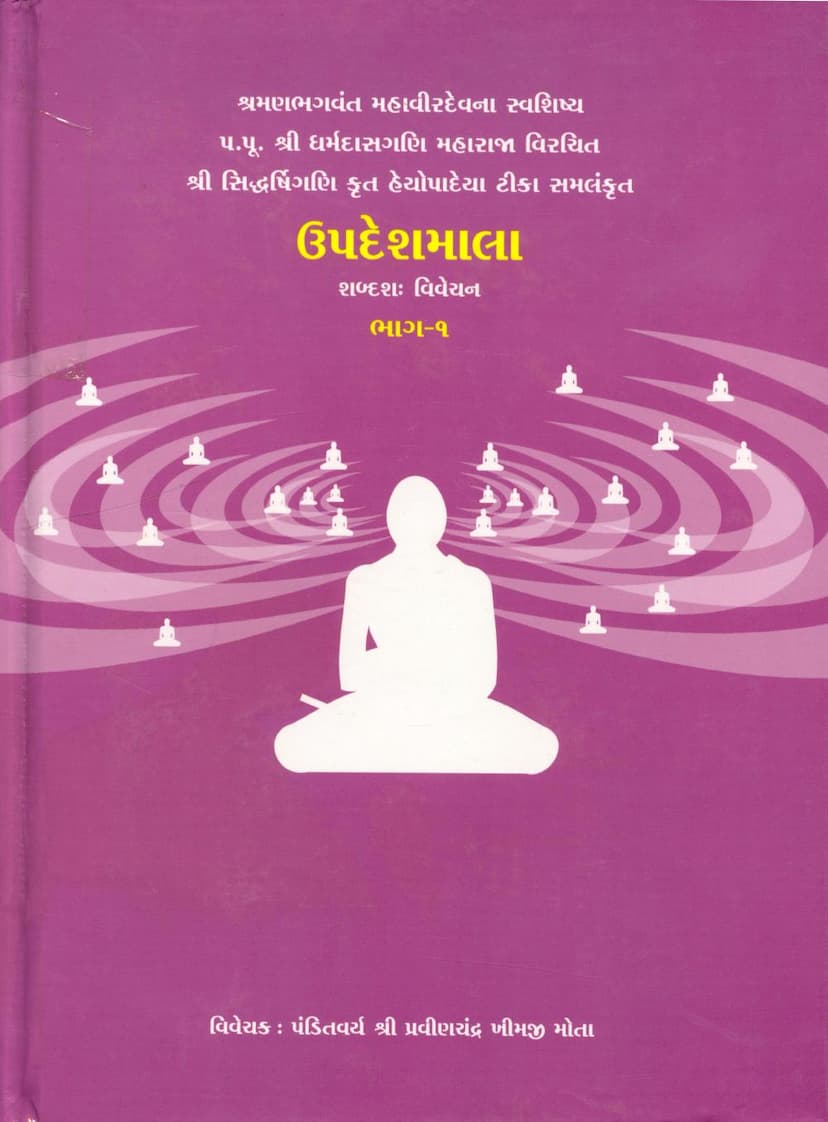Updesh Mala Part 01
Added to library: September 2, 2025

Summary
Here's a comprehensive summary of the provided pages from "Updesh Mala Part 01" in English:
Book Title: Updesh Mala Part 01 (ઉપદેશમાલા ભાગ-૧) Author(s): Dharmdas Gani (original text), Siddharshi Gani (commentary), Pravin K Mota (exposition/commentator) Publisher: Gitarth Ganga Catalog Link: https://jainqq.org/explore/022177/1
Overview:
The provided text is the first volume of "Updesh Mala," a significant Jain scripture, presented with a detailed word-by-word exposition (शब्दशः विवेचन) by Pandit Shri Pravinchandra Khimji Mota. The original text is attributed to Acharya Dharmdas Gani, a disciple of Lord Mahavir, and it includes a commentary called "Heyopadeya" by Acharya Siddharshi Gani. The publication is supported by divine grace from Acharya Shrimad Vijay Ramchandrasurishwarji Maharaj and Acharya Bhagwant Shrimad Vijay Yugbhushansurishwarji Maharaj.
Key Themes and Content Summary (Based on Pages 1-21):
-
The Nature of the Text: "Updesh Mala" is a collection of essential teachings and moral guidance, designed to help individuals understand what is to be accepted (upadeya) and what is to be rejected (heya) in the path of spiritual progress. The exposition aims to reveal the profound, hidden meanings within the text through the interplay of various scriptural passages and logical reasoning.
-
Mangalacharan (Invocation): The text begins with a mangalacharan (auspicious invocation) in Sanskrit (verses 1-2). The commentator, acknowledging his perceived intellectual limitations ("jadtibuddhi" - dull intellect), dedicates himself to explaining "Updesh Mala" for the benefit of those with lesser understanding, under the guidance of the divine wisdom inherent in Jinendra's teachings. He pays homage to the Tirthankaras, comparing them to the sun that dispels the darkness of wrong views.
-
The Purpose of the Exposition: The commentator emphasizes that the essence of "Updesh Mala" is not merely a superficial understanding of words but a deep, profound grasp of its meaning derived from scriptural references and context. He highlights the importance of profound knowledge of the Jain Shasan (teachings) beyond mere attainment.
-
The Tirthankaras as Guides: The text reveres the Tirthankaras, particularly Lord Rishabhdev (the first Tirthankara) and Lord Mahavir (the last Tirthankara). They are described as the "Chudamanibhut" (crest jewel) of the world, the light of the three worlds, and the sole means of guiding beings out of suffering.
-
The Importance of Tapas (Austerities): Verse 3 illustrates the rigorous austerities practiced by Tirthankaras like Lord Rishabhdev (one year of fasting) and Lord Mahavir (six months of fasting). This is presented as an example for ascetics to emulate the practice of austerities with utmost effort, as it is a crucial path to liberation.
-
The Virtue of Kshama (Patience/Forgiveness): Verse 4 emphasizes the practice of Kshama, exemplified by Lord Mahavir, who, despite enduring immense suffering and atrocities inflicted by ordinary beings in his past lives, remained steadfast and composed. This virtue is presented as essential for all ascetics.
-
The Steadfastness of the Enlightened: Verse 5 compares the enlightened beings to Mount Meru, which remains unshaken by the fiercest winds. Similarly, the steadfast disciples remain unperturbed by the thousands of challenges and hardships (upasarga) they face, their focus unwavering on the ultimate goal of liberation.
-
The Importance of Vinay (Humility/Respect): Verses 6-8 highlight the virtue of Vinay. They describe the ideal qualities of a first Ganadhara (chief disciple) – possessing complete knowledge (Sampurna Shruta Gyani), but still approaching the Lord with humility and asking questions, even if they already know the answer, to benefit the assembly. This is further illustrated by the example of people respecting their king, emphasizing the need for disciples to show utmost respect and obedience to their Guru.
-
The Nature of a True Guru: Verses 9-11 elaborate on the characteristics of a true Guru. They describe a Guru as one who is radiant, the leader of their era, possessing comprehensive scriptural knowledge, eloquent, profound, steadfast, devoted to imparting knowledge, pure, gentle, compassionate, accepting of vows, and wise. Such a Guru is seen as the source of true spiritual guidance and a beacon of virtue.
-
The Significance of the Guru: Verse 12 explains why such qualities are essential in a Guru. The Tirthankaras, through their teachings, have shown the path to an eternal, untainted existence. However, in their absence, it is the Guru who preserves and propagates this divine knowledge, ensuring that the Jain tradition (pravachan) continues to thrive without deviation. Therefore, the qualities of a Guru are paramount for the continuity and integrity of the Shasan.
Overall Tone and Purpose:
The initial pages establish a tone of profound reverence for the Tirthankaras and the Jain teachings. The exposition by Shri Pravinchandra Mota aims to make these profound teachings accessible and understandable, emphasizing the practical application of virtues like knowledge, tapas, patience, humility, and the importance of following a qualified Guru. The text serves as a guide for spiritual aspirants, highlighting the path to liberation and the conduct required to achieve it.